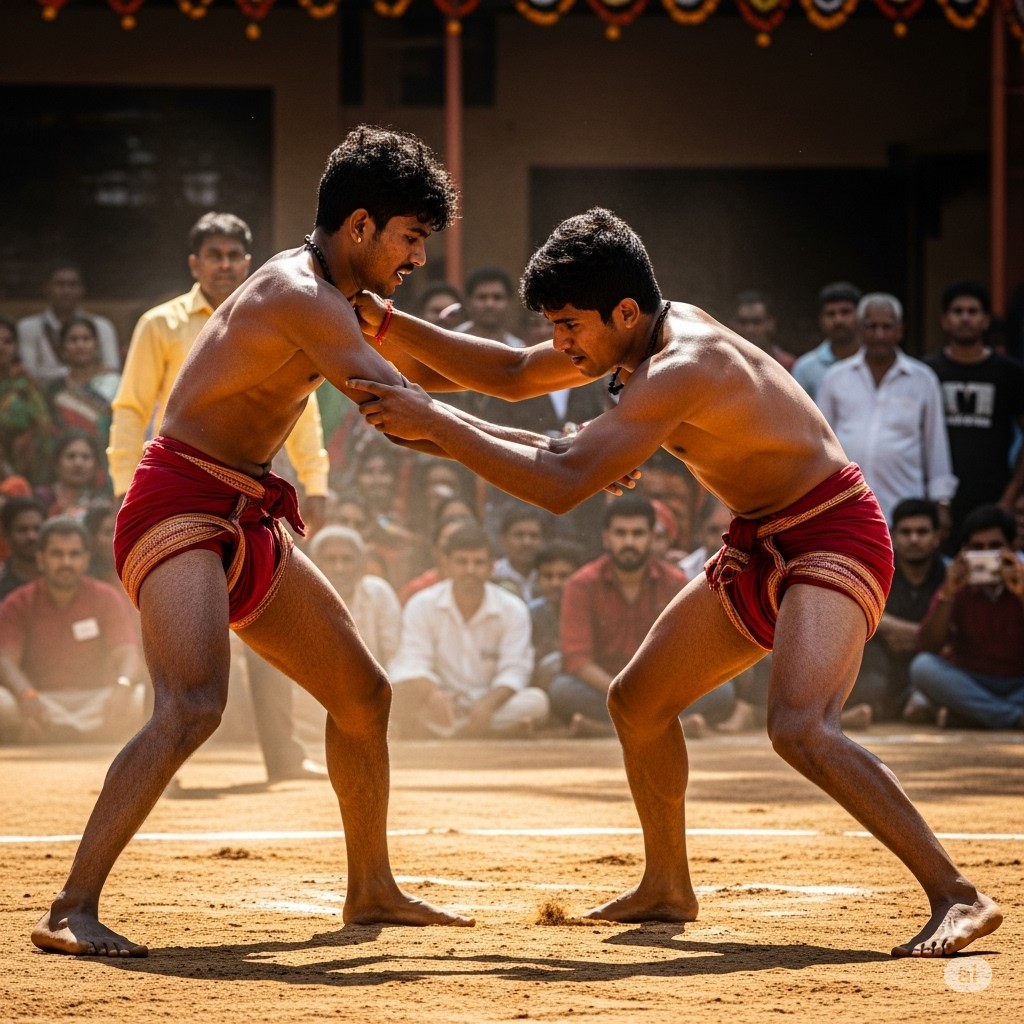
Malla-Yuddha: A Timeless Martial Tradition
Malla-Yuddha, an ancient form of Indian wrestling, holds a special place in the history of combat sports. Known for its blend of strength, strategy, and cultural depth, this martial art has endured the test of time. It has captivated practitioners and enthusiasts for centuries. Its intricate techniques, historical significance, and enduring legacy make it a compelling subject for exploration.
Origins and History of Malla-Yuddha
The roots can be traced back over 5,000 years to the Vedic period. It is mentioned in ancient texts like the Mahabharata and the Ramayana. These epic narratives often describe legendary warriors engaging in wrestling bouts. The sport also finds mention in classical Indian treatises such as the Manusmriti and the Arthashastra, which elaborate on its techniques and societal importance.
Malla-Yuddha emerged as both a form of entertainment and a method of physical training for warriors. Temples and akharas (wrestling schools) became centers for training in the art. The practice evolved alongside Indian society, incorporating influences from local traditions and rulers. During the Mughal era, it saw a fusion with Persian wrestling styles, leading to the development of modern Indian wrestling, or Pehlwani.
Global Popularity and Regional Presence
Though rooted in India, it has left an indelible mark on the global wrestling landscape. In countries like Nepal, Bangladesh, and Sri Lanka, the sport’s techniques and rituals have been adopted. Outside South Asia, Malla-Yuddha’s influence can be seen in traditional wrestling styles across Southeast Asia and the Middle East.
Internationally, wrestling enthusiasts have recognized Malla-Yuddha for its historical significance and technical complexity. Cultural festivals in Europe and North America have featured demonstrations of this ancient art. As a result, awareness and appreciation has grown steadily in recent years.
In India, regions like Haryana, Punjab, and Uttar Pradesh remain strongholds of the sport. Akharas in these areas continue to train wrestlers, preserving the techniques and traditions of Malla-Yuddha. Annual tournaments draw large crowds, showcasing the enduring appeal of this age-old martial art.
Amateur Malla-Yuddha: Grassroots Engagement
Amateur Malla-Yuddha thrives as a community-driven sport. It is often introduced to children through akharas, which serve as hubs for training and mentorship. These schools emphasize discipline, physical fitness, and the values of sportsmanship. Youth competitions, held in rural and urban areas alike, provide a platform for young wrestlers to showcase their skills.
In schools, it is increasingly included as part of physical education programs. This integration has helped nurture interest among younger generations. Workshops and exhibitions further promote the sport, bridging the gap between tradition and modernity.
The rise of social media has also contributed to the visibility of amateur Malla-Yuddha. Enthusiasts share training routines, match highlights, and instructional content online, attracting a global audience. Consequently, the sport’s grassroots popularity continues to grow.
Professional Leagues and Organizations
Professional Malla-Yuddha has gained momentum with the establishment of leagues and associations. These entities aim to formalize the sport and provide wrestlers with structured opportunities for competition. The Indian Wrestling Federation and other regional bodies play a pivotal role in organizing tournaments and maintaining standards.
Events such as the Kushti championships in India serve as flagship competitions for professional wrestlers. These tournaments often feature matches under traditional rules, drawing both local and international participants. Cash prizes, sponsorships, and media coverage have elevated the status of professional Malla-Yuddha.
Globally, organizations have begun to include Malla-Yuddha-inspired techniques in martial arts and wrestling circuits. Mixed martial arts (MMA) promotions have also incorporated elements of the sport, highlighting its relevance in contemporary combat sports. This cross-disciplinary influence underscores the adaptability and significance of Malla-Yuddha.
Political and Social Significance
Malla-Yuddha holds profound political and social importance. Historically, it symbolized the strength and valor of communities, serving as a medium for asserting identity. Kings and rulers patronized wrestlers, using the sport as a tool for diplomacy and cultural exchange.
In modern times, it continues to foster community cohesion. Local tournaments bring people together, transcending barriers of caste, creed, and socioeconomic status. The sport’s inclusive nature promotes unity and mutual respect among participants and spectators alike.
Politically, it has been used to highlight India’s rich cultural heritage on international platforms. Demonstrations during diplomatic events and cultural festivals showcase the art’s historical depth. Additionally, governmental initiatives aimed at preserving traditional sports have provided financial and infrastructural support to Malla-Yuddha practitioners.
Rules and Techniques of Malla-Yuddha
It follows a distinct set of rules designed to ensure fairness and safety. Matches typically take place in a circular arena, marked with soft soil or sand. Wrestlers aim to pin their opponent’s shoulders to the ground, signaling victory.
The sport emphasizes four primary techniques:
- Hanumanti: Focused on technical superiority and skillful maneuvers.
- Jambuvanti: Centered on strength and endurance to overpower opponents.
- Jarasandhi: Involving joint locks and submission holds.
- Bhimaseni: Relies on brute force and aggressive tactics.
These techniques reflect the versatility and depth of Malla-Yuddha. Wrestlers train rigorously to master them, balancing physical fitness with mental acuity.
Judges oversee matches, ensuring adherence to rules and determining outcomes. Penalties are imposed for fouls, such as striking or unsportsmanlike conduct. This structured approach upholds the integrity of Malla-Yuddha, preserving its traditional essence.
Conclusion
Malla-Yuddha remains a testament to the enduring appeal of traditional sports. Its rich history, cultural significance, and evolving practice continue to inspire athletes and enthusiasts worldwide. By embracing both its roots and modern applications, Malla-Yuddha bridges the gap between past and present. As the sport gains recognition globally, it stands poised to reclaim its rightful place as a cherished martial tradition.




